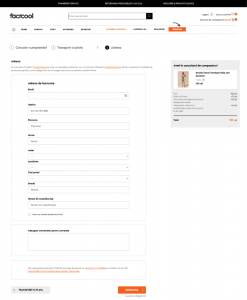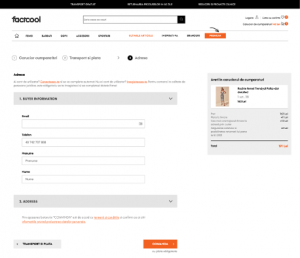There are plenty of solid players in the apparel and fashion category, while Factcool has started as an underdog in the industry.“We just copied the solutions, which competitors had and just put it on the web, and it did not have such great results as we thought it would.”, shares M.Stračár from Factcool. When competitors experiment on new features, the simplest thing to do is copy them. Still, it may have adverse consequences: “This type of user experience development was costly as we had to develop some humongous changes and features to only then see if they caused any improvements or not.”
Based on Jakob’s Law of Internet User Experience, users spend most of their time on other sites. Users prefer a site to work the same way as all the other sites they already know—design for patterns users are accustomed to. There are plenty of solid players in the apparel and fashion category, while Factcool has started as an underdog in the industry. Sometimes it may seem like a good idea to copy your competition. “We just copied the solutions, which competitors had and just put it on the web, and it did not have such great results as we thought it would.” When competitors experiment on new features, the simplest thing to do is copy them, but it may have adverse consequences. “This type of user experience development was costly as we had to develop some humongous changes and features to see then if they made any improvements or not.”
Significant website changes make great impressions at the board meeting because they are tangible and apparent, while small changes may go unnoticed for months. These two approaches differ significantly. One requires a significant investment of time and money, while the other needs a well-defined process and customer focus. The value of Conversion Rate Optimisation (CRO) shines through once you understand that you are not optimising your website to impress your board. Instead of looking at the big design changes, it is much better to look at the bottom line of your financial statement.
“Unfortunately, the big changes were not bringing the results that we expected. So the old mantra of the revolutionary approach based on following the competitors had to be abandoned. Instead, we focused on our user problems. Top management changed and brought a different approach. They also had the experience, necessary knowledge and the will to do things differently. The new way allowed us to implement improvements faster and measure their impact more accurately. Yes, the changes were smaller, but the results were more tangible.” Instead of analysing in, what may only be called, historical way, when you note the results, then implement a change and compare results to the previous period, it is more precise to have website traffic split in two and begin A/B testing.
Factcool was surprised and delighted to see what kind of difference a change in a small thing like a basket clearance logic or the sequence in which you add information during the purchase makes. One of the quick wins we identified was in the user behaviour data. There was a considerable Checkout abandonment rate: 75.1%, and in this step, visitors spent most of the time while the Exit Rate was highest compared to other steps. Through further investigation, we found that the number of form fields might scare visitors away, as it immediately feels like there’s a lot of effort needed to complete this step. We proposed a variation that would divide the form into two manageable sections and create a feeling of less effort required.


Unconditional Agency works in categories ranging from tourism to clothing to jewellery. Factcool has experienced the value of it first hand: “We usually benchmark ourselves with the direct competition and are quite blind to other segments.” All hypotheses that Unconditional Agency created were rooted in Factcool website visitors behaviour. Still, the solutions to that behaviour came from various past experiences, and these created massive value because they were new to the whole category and added to Factcool uniqueness.
Factcool understood that user behaviour changes over time, and it is worth rechecking the solution to the problems that consistently reappear in the analysis. “It was interesting to see that of the 20 Hypotheses that you have prepared, we have tested about three already. Our view about what issues we should solve first had merit. We were happy to retest these as some time has passed since we explored these areas.” Testing is a fantastic way to figure out how to optimise for better conversions, but we understand that it is always tough to find time to do it when it comes to testing. We are not talking about developing, we mean finding the problems, creating the solutions, and then testing them, getting data and delivering the winning code.
“By outsourcing conversion rate optimisation, we can get more insights and create a better experience for our users. Then we saw the change in the bottom line. Through this process, we have learned to listen to our customers more and test if it works rather than think it will work.”
“I recommend Unconditional Agency wholeheartedly because they have the industry insights and provided us with a better overview of the industry as a whole. I like your approach because you reveal what will work in the audit but test everything anyway. You found a lot of small changes that brought a tangible increase in revenue.”



